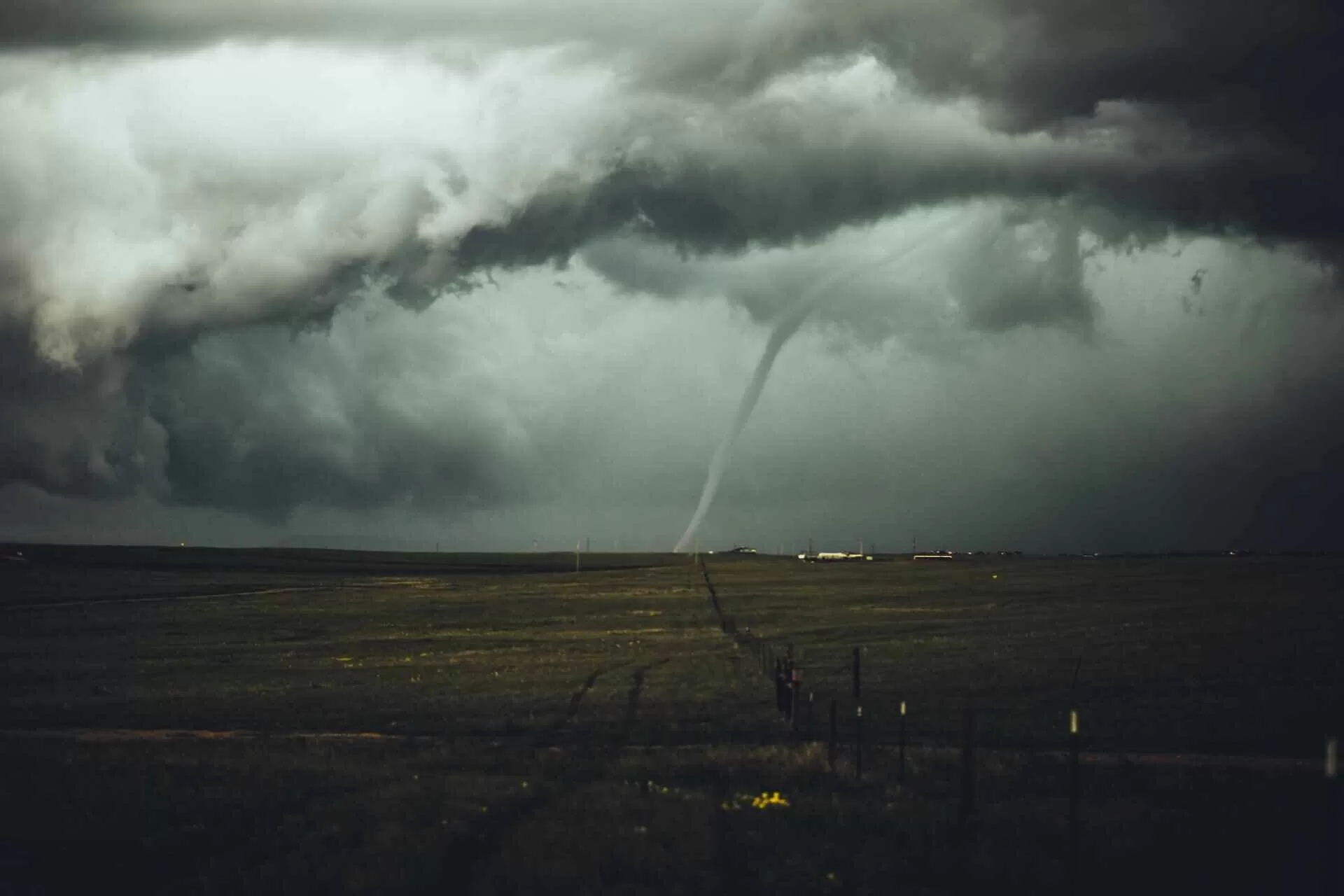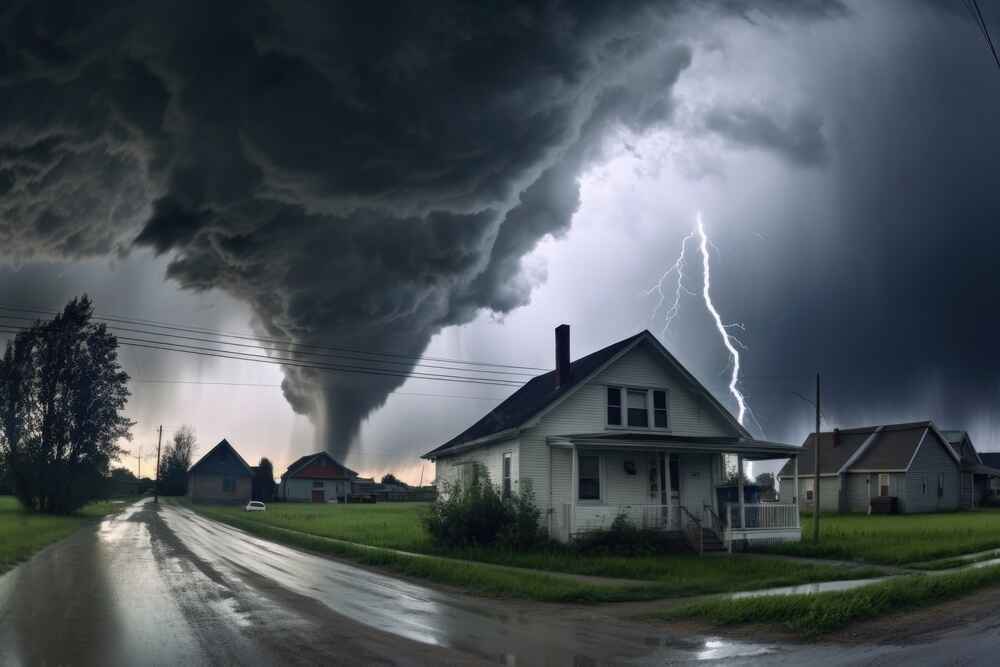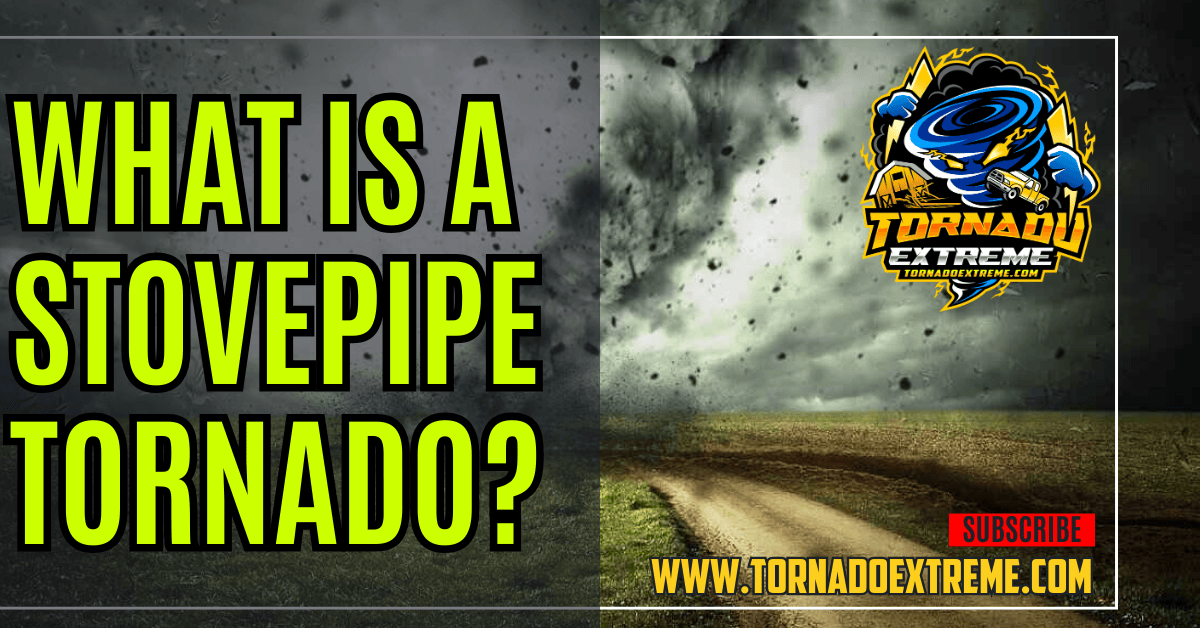Understanding the Stovepipe Tornado
Of all the tornadoes that exist, the stovepipe tornado is the one that delivers both fear and awe. To better understand this monster, you must first understand what a tornado is. Picture a funnel cloud with powerful winds tearing through everything in its path, and that’s exactly what a tornado is known for. These destructive windstorms usually develop from thunderstorms accompanied by heavy rain and severe weather. But among the various types of twisters out there, it’s easy to spot the stovepipe by its appearance alone: it looks like a giant pipe stretching from the sky down to Earth.
Are Stovepipe And Cone Tornadoes The Same?
They share many similarities and are typically found in the same areas across the United States, but there is a key difference between stovepipe and cone tornadoes. At their core, stovepipe tornadoes maintain a consistent width from the bottom to the top, showcasing its vast size and dangerous capabilities. On the other hand, cone tornadoes start off much smaller at the base and expand as they rise into the sky. Some people see the two types of tornadoes as connected, with one being a sub-class of another due to these common characteristics.
However, there is an obvious difference that can’t be ignored; their shape doesn’t match up clearly.. But despite this disparity there are more similarities than differences between these two types of weather phenomena. They both come from a thunderstorm and have a base that connects them together.
See also: Green Sky Tornado: Why Does the Sky Turn Green?
5 types of tornadoes
Tornadoes come in a variety of forms. And for good reason, too. Each kind has its own unique characteristics and traits that make it extremely different from one another. There’s the supercell type, which is the most common and usually the most destructive; packing winds of over 200 mph. Then there’s the wedge type – one of the most dangerous according to U.S National Weather Service.
There’s also multi-vortex twisters, which are little tornadoes swirling around a central point. Landspout twisters form at ground level and are generally weaker than all other types. Lastly, we have waterspout twisters – these bad boys start out on bodies of water before eventually moving onto land.
Each class presents its own one-of-a-kind threats and should be taken seriously by anyone facing them head-on. It’s imperative to respect each tornado for what it is: A natural disaster coming right at you. If ever warned or informed about an upcoming tornado, take immediate action by seeking safety in a well-built structure like a basement or interior room without any windows.
If you happen to be outdoors when this starts then I suggest finding cover in an area that’s low to the ground so that you can lie flat while shielding your head with your hands. Make sure you know all the different kinds of warnings and precautions before they hit too!

Supercell Thunderstorm
The creation of these cylindrical twisters begins inside what’s called a supercell thunderstorm – an intense storm that produces long-lived severe weather conditions like them. The reason why these two always seem to go hand in hand is because Stovepipe tornadoes rely on supercell storms to form when certain atmospheric conditions are met. Usually caused by strong updrafts within the supercell thunderstorm, their iconic shape comes from air rotating downwards toward Earth.
Size Matters
Notorious for their narrow width with little variation as it gets further away from their base or top. Which give them the shape they have, like a vertical pipe Since not all tornadoes look alike but they do share similarities that make them fall into certain categories based on their appearance; cone and stovepipe appear to be completely different at first glance, but upon closer inspection you’ll find they possess similar traits other than how they look..
If you’re under a tornado warning, the weather service says you should seek shelter immediately in a sturdy building, preferably in a basement or an interior room without windows. If you are outside or on the road, find a low-lying area and lie flat, covering your head with your hands.Understanding the different types of tornadoes can help with preparedness and response when severe weather strikes. Being informed and having a plan in place can make all the difference in staying safe during these powerful and often unpredictable storms.
Are Stovepipe Tornadoes The Most Dangerous Kind Of Tornado?
Wedge-shaped twisters are considered violent tornadoes, which are rated EF-3 or higher on the Enhanced Fujita Scale. As their name implies, these twisters are known for being very wide — much like every other large tornado mentioned above. Some of the most deadly storms ever recorded have been wedge-shaped tornadoes because they cause more destruction than any other type.
While stovepipe tornadoes maintain a consistent width along their entire length, wedge tornadoes start wide at the bottom and get wider as they climb into the sky. If you’ve ever seen one from up close (which I don’t recommend doing), it will look like an enormous mass of black clouds surrounding everything below it.
Most wedge-shaped tornadoes span at least half a mile across— if not more— according to meteorologists’ estimates.
This is why they leave such incredible amounts of damage behind them whenever they touch down: They’re able to push stronger winds into buildings and structures than narrower twisters can.
Characteristics And Formation Of Stovepipe Tornadoes
Stovepipe-like features give this sort of twister its name because it looks like an old-fashioned cylindrical metal heating duct as it moves along. While some tornadoes may appear ropey or tapered when viewed from afar, stovepipe funnel clouds stay about as thick as they are tall — which makes them pretty easy to identify.
According to the article, the formation of a stovepipe tornado is based on how supercell thunderstorms function. These types of storms are long-lasting and powerful, which means that they create the perfect conditions for twisters to form.
A strong updraft at the center of a supercell creates a rotating wall of air known as a mesocyclone, which is the first step in forming a tornado. As it becomes stronger, this mesocyclone can eventually turn into a full-blown vortex within the cloud base.
This vortex will then drop out of the bottom of the storm, creating one end of what looks like an incredibly long tube. This funnel will continue dropping down until it reaches solid ground or dissipates back into thin air — depending on whether or not it has enough energy to stay alive.
The source says that warm and moist air constantly gets sucked into this rapidly spinning column from beneath the storm’s base while it’s still hanging in midair. The wind’s relentless pecking allows these types of twisters to maintain their cylindrical shape throughout almost their entire lifetime.
But even though researchers understand some things about how supercells work and when they’re most likely to spawn tornadoes, scientists still don’t know why certain storms produce violent funnels while others simply don’t.
Although all tornadoes are known for being destructive and can cause a great deal of damage, events involving stovepipe tornadoes have proven to be especially harsh on the communities affected by them. Take for instance this particular event that occurred in the plains of central United States, where a fierce stovepipe twister ripped through everything in its path.
This all happened on a very spring day when severe thunderstorms festered multiple tornadoes across the region, including several stovepipe ones. The most devastating one showed an extraordinary amount of strength and persistence, carving a long trail of destruction through small towns and farms everywhere. Alongside its mighty strength came that familiar cylindrical shape that marked itself on the minds of those who caught glimpse of its power.
Afterwards, communities banded together to help those affected recover from the wreckage left behind by this destructive force. This unity was there as it served as proof against claims that humans don’t help each other enough. With such devastation surrounding them, it would’ve been easy for them to become even more selfish than they already were during normal times. Instead they stepped up and proved their worthiness in aiding others during times like these, which ultimately served as a reminder that being there for someone else is one of the best things you can do.
See also: What is a Waterspout Tornado?
Notable Stovepipe Tornado Events
Though tornadoes are always a dangerous and have the potential to cause havoc, certain events with stovepipe tornadoes have left a long-lasting impact on the communities they affect. One such event took place in the plains of central United States where an intensely powerful stovepipe tornado ripped through the Earth’s outskirts, causing mass destructions.
The incident occurred on an unfortunate spring day when a series of severe thunderstorms formed across the land. These storms gave birth to multiple tornadoes including several stovepipes ones. The most terrible one exhibited superhuman strength and persistence as it plowed through rural communities and farmland. Those who witnessed its wrath were awestruck by its distinctive looks; it was shaped like a cylinder and it was fearsomely intense.
Aftermath of this catastrophe many people worked together to help those hit worst by this devastating force of nature. Communities uniting in times of need is something that never fails to amaze, they showed that even in darkest times humans can stand up for each other and provide support in ways unimaginable. This event also shed light on how important it is for us to be ready and informed about possible threats such as stovepipe tornadoes or water spouts
Stovepipe Tornado VS Traditional Tornado
When comparing your typical twister with one shaped like a stovepipe tornado, you will find many differences between their two already distinct appearances. Your usual rope-like cyclone is much more slender and elongated compared to one that maintains its width. Think about how much room you need if you’re going to slide down something like a rope versus needing no additional space because it’s as wide as it needs to be at any given point.
Another difference lies within what they look like when seen from afar. One looks more intimidating than the other due to its imposing figure – towering menacingly over homes and streets alike without an ounce of remorse. The other just kind of looks like a thick line slowly sweeping the ground. It’s no wonder why people are so fascinated with the more menacing looking one because it truly does look like a twisted representation of nature’s power.
Though one may appear to be more destructive than the other, both are capable of doing plenty damage on their own. Both twisters can carry debris and bring in winds strong enough to tear down buildings, uproot trees, and completely level any infrastructure that gets in their way. When witnessing something as intimidating as a stovepipe tornado emerging from the skies, it becomes clear how critical preparedness is in these situations according to information provided by the National Weather Service.
Stovepipe Tornado in West Virginia
West Virginia has seen its share of severe weather events throughout history, including those brought on by stovepipe tornadoes. In one particular instance, this powerful supercell thunderstorm gave birth to a twister unlike many have ever seen before – A U.S Department of Commerce labeled stovepipe tornado emerged from within those erratic clouds just above the state’s tall mountains.
The cylindrical vortex was observed as it grew, and the sight of it caused residents and authorities to be worried. The mountainous terrain of West Virginia is not a common place to see a stovepipe tornado, so the uncommon occurrence reminded everyone how unpredictable severe weather can be, but also how important it is to be prepared for events like this. Even though the tornado didn’t end up causing much damage, its presence in the region did remind everyone about the potential harm that could happen.
Seeing a stovepipe tornado in West Virginia had many people thinking about what they need to do if an emergency were to occur again. People who live here are now aware that being ready for severe weather is essential. This event also gave them a glimpse at how powerful nature can be and sparked their interest in monitoring and forecasting similar events again — as well as how information should be shared with the public when necessary — just so safety never has to bet compromised.

Safety Precautions
While every large tornado carries some kind of threat, some are more dangerous than others. Safety precautions have proven time and time again that they do help save lives. In addition to having your family create an emergency plan on where you will meet if tornados were coming or even other large natural disasters, all individuals should identify safe places around their home or community where they can seek shelter during a tornado warning.
Especially those who live in regions prone to stovepipe and cone tornados which are much wider than typical ones.. And yes this does mean doing your homework on how big each type gets! Everyone should have a kit with them at all times that contains important documents along with food, water (preferably non-perishable), first aid supplies, batteries… etc.
Stay Informed
Not staying up-to-date on news might seem ideal these days but trust me — weather updates aren’t something you want to ignore. It’s crucial that you know when storms are coming, especially if there is a chance of tornado activity. Make sure that your phone and television settings are set to receive emergency alerts. This will help you stay informed about what’s going on around you so you can plan accordingly.
Seek Shelter Promptly
When a tornado warning does get issued for your area, don’t wait around to see what happens — save yourself the danger and just go straight to safety. Find a sturdy structure with thick walls that preferably has a basement or an interior room on the lowest level (if this isn’t possible, then get as low as possible). Most importantly, do not put yours or anyone else’s lives at risk by sticking around windows or exterior walls while it is happening.
Practice Drills and Training
As annoying as regular drills might be, they do play an important role in ensuring everyone’s safety during times like these. Practice seeking shelter and implementing your emergency plans so when the time comes to act, everyone is prepared.
By thinking ahead and preparing for the worst-case scenario ahead of time, vulnerable populations will be able to protect themselves better from harsh weather conditions. The development of technology has helped predict much more than we thought was ever possible in years past but it can only do so much… It’s up to all of us to work together to take as many precautions as we can during these situations.
Meteorologists and research institutions don’t just throw darts at a map to predict tornadoes. The science is much more complex than that. It involves the careful analysis of numerous factors that help forecast not only the possibility of a tornado, but its size and power.
Radar observations, computer simulations, satellite imagery—all of these are used to analyze conditions in the atmosphere to determine if they’re ripe for severe weather. By looking at all this data, researchers can determine if there is a good possibility of twisters in certain regions.
When it comes to “stovepipe” tornadoes specifically (tornadoes that are wide near the ground but narrow at their top, resembling a stovepipe), scientists look closely at supercell thunderstorms. These storms have mesocyclonic structures and specific updraft dynamics that suggest a possible tornado could form. Based on this information, they can then warn people about what’s coming.
The more accurate and timely forecasts become, the better communities will be able to protect themselves from harm. That’s why meteorologists work tirelessly to integrate real-time monitoring data with predictive models—so everyone has as much time as possible to be prepared.
Researchers want to make sure those preparations aren’t wasted by continuously working on their forecasting and monitoring techniques for stovepipe tornadoes. They aim to enhance safety outcomes and improve risk reduction when dealing with these incredibly powerful weather events.
See also: What Is a Multi Vortex Tornado? A Comprehensive Exploration
Historical Impact of Stovepipe Tornadoes
Stovepipe tornadoes have had a profound impact on humanity throughout history. If you speak with someone who lived through one or experienced their destruction firsthand, you’ll understand how scary they really are.
Consider an event where one of these twisters tore through a rural community in America’s Midwest region. The intense winds turned homes into rubble and ripped trees from their roots—causing damage you’d expect from such an awe-inspiring force.
Afterward, communities came together and rebuilt what they had lost. It demonstrated the strength and determination of people even in the face of such a terrifying natural disaster.
In the aftermath of the event, communities rallied together to rebuild and recover, demonstrating resilience and solidarity in the face of adversity. The historical impact of stovepipe tornadoes serves as a reminder of the enduring capacity of communities to rise above the challenges posed by severe weather events, exemplifying the strength and determination inherent in the human spirit.
Research and Studies on Stovepipe Tornado Phenomenon
Meteorologists know how powerful stovepipe tornadoes can be, so there’s massive value in doing research on them. They want to understand how they form, move and interact with other types of storms inside their environment.
Using various tools at their disposal—like observational data, numerical modeling and field studies—scientists will attempt to predict these events better in future. If they can understand the mechanics behind supercell thunderstorms and what triggers a tornado within them, they’ll be able to give people more time to prepare for what could become a devastating occurrence.
Along with their physical dynamics, the societal and environmental effects of stovepipe tornadoes are also studied. These are how they influence communities, infrastructure and natural landscapes. By comprehensively understanding these aspects of stovepipe tornadoes, researchers can help us prepare for them when they come.
The impact that research on stovepipe tornadoes has could potentially save a lot of lives and resources. It may even help us recognize what kind of structures could be built to withstand them.
To conclude, the complexity of a stovepipe tornado is captivating in many ways. From its attributes as an individual event known for its narrowness to how it’s formed within a supercell thunderstorm; it’s no wonder there’s so much interest in studying them still to this day.
As we all fear the potential devastation from a stovepipe tornado, it’s important that we stay prepared through constant vigilance and studies like these. By better understanding why and how these types of storms occur, then using that information to predict future events; we’ll be able to save more lives than ever before.
With the knowledge we already have about meteorology, we’re on the right path towards reducing the destruction caused by stovepipes. We just need to continue researching into them so that one day very soon, humanity will no longer live in fear of such catastrophic events.

Conclusion
All in all, the mysterious nature of stovepipe tornadoes holds a seemingly infinite number of scientific, historical, and societal dimensions that keep us intrigued while challenging our knowledge of severe weather. From the way they are formed and their unique characteristics, to their history and future research, stovepipe tornadoes have a prominent place in the world of meteorology and public safety.
While cities and towns spend time preparing for these highly dangerous phenomena, keeping vigilant and staying ahead in research remains crucial. Having an advanced understanding of how these tornadoes behave when put into different conditions— as well as having effective forecasting methods—are key ways we can work towards minimizing damage on vulnerable populations.
The fight for more knowledge and innovation within this field will eventually provide us with all the answers we need to face off against stovepipe tornadoes headfirst. With that newfound knowledge, we’ll be able to confront these events with foresight, readiness, and collective resolve.

